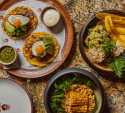Flaounes
Enjoy these flaounes – cheese-filled pastries that are an Easter tradition for Greek-Cypriots – at any time of day alongside a cup of tea
-
Prep:40 mins
Cook:30 mins
plus 1 hr resting - Serves 6
- More effort
Nutrition per serving
-
kcal 567
-
fat 31g
-
saturates 11g
-
carbs 49g
-
sugars 0g
-
fibre 3g
-
protein 22g
-
salt 1.3g
Ingredients
- 2 eggs
- 250g grated cheese (a mixture of halloumi and cheddar works well, see tip below)
- 35g semolina
- 12g fresh yeast or ½ tsp fast-action dried yeast
- ¼tsp caster or granulated sugar
- ½ tsp baking powder
- small handful of mint, finely chopped, or ½ tbsp dried mint
- 35g sultanas or raisins
- 300g plain flour, plus extra for dusting
- ¼ tsp baking powder
- pinch of ground mastic ground (optional, see tip)
- pinch of mahlepi ground (optional, see tip)
- ¼ tsp caster or granulated sugar
- 60ml sunflower oil
- 160ml lukewarm milk
- 50g sesame seeds
- 1 egg, beaten
Tip
Flaouna cheese made using sheep or goat’s milk is available in specialist grocers at this time of year. It’s mild like pecorino and is often mixed with halloumi for flaounes. Using cheddar will give you a saltier taste.Mastic gum or mastiha is the resin from a shrub of the same name native to the Greek island of Chios. It is sold as crystals or granules.
Mahlepi is made from the ground kernels of pips from cherry trees – they are an aromatic, fruity spice, shaped like seeds, and often used in breads and pastries in Greece and Cyprus.
Method
If you have time, make the filling 2-3 hrs ahead so it develops more flavour. Whisk the eggs in a bowl until frothy. In a separate bowl, combine the grated cheese with the semolina, then make a well in the middle, tip in the yeast and 1 tbsp of the beaten egg. Mix to combine, then add the remaining egg – the mixture will be fairly firm. Add the sugar, baking powder, mint and sultanas or raisins, then mix again until the fruit is evenly distributed. Cover the bowl with a tea towel and set aside to rest until needed.
For the pastry, combine the flour, baking powder, mastic and mahlepi (if using) and the sugar. Tip in the oil and rub this into the flour mixture using your fingertips, then gradually mix in the milk (you may not need it all) until you have a soft dough. Cover with a tea towel and set aside to rest for 1 hr.
For the topping, tip the sesame seeds into a fine sieve, rinse with cold water, drain and spread out on a clean tea towel to dry slightly. Heat the oven to 200C/180C fan/gas 6 and line a baking tray with baking parchment. Once the dough has rested, divide it into six pieces, about 80g each. Roll each out on a lightly floured surface into a 16cm disc, about ¼cm thick. Lay each disc on the sesame seeds (on one side only) so they stick.
Divide the filling into six and shape into balls (about 65g each). Place one ball of filling into the middle of each pastry disc on its plain side. Lift the left and right edges of the pastry over the filling so it slightly overlaps it at the edges, leaving the middle exposed. Repeat with the top and bottom edges.
Brush the pastry with the beaten egg and bake for 15 mins. Reduce the oven to 180C/160C fan/gas 4 and bake for 15-20 mins more until golden and risen in the middle.





















